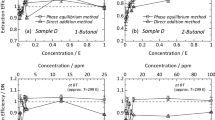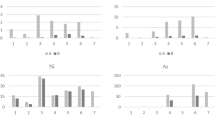Abstract
The Industrial Safety and Health Act in Japan has established guideline values for volatile organic compounds (VOCs) in indoor workplace air; however, because the physicochemical properties of these VOCs are diverse, appropriate analytical methods have not yet been developed. Here we performed recovery tests to simultaneously measure VOCs and to optimize the analytical parameters (the extraction solvents and their mixture ratio) of a commercial activated carbon–silica gel active sampler. In the recovery tests, 46 VOCs were added to the adsorbents of the sampler (activated carbon and silica gel) at three concentration levels relative to the guideline values (0.5×, 1×, and 2×); we then extracted the VOCs from the absorbents by using various mixtures of acetone and carbon disulfide. The mixture comprising 80% acetone and 20% carbon disulfide was the best solvent overall for extracting the 46 tested VOCs from the adsorbents in the sampler; this mixture achieved adequate recovery rates (within the range of 80 to 120%) for 40 (87%) of the targeted VOCs.




Similar content being viewed by others
References
Abiko H (2015) The organic solvent extraction efficiency of activated carbon used in sampling tube products. TANSO 2015:201–208
Alves CA, Evtyugina M, Cerqueira M, Nunes T, Duarte M, Vicente E (2015) Volatile organic compounds emitted by the stacks of restaurants. Air Qual Atmos Health 8(4):401–412
Attarchi M, Golabadi M, Labbafinejad Y, Mohammadi S (2013) Combined effects of exposure to occupational noise and mixed organic solvents on blood pressure in car manufacturing company workers. Am J Ind Med 56(2):243–251
Chen X, Feng L, Luo H, Cheng H (2014) Analyses on influencing factors of airborne VOCs pollution in taxi cabins. Environ Sci Pollut Res 21(22):12868–12882
Delfino RJ, Gong H, Linn WS, Hu Y, Pellizzari ED (2003) Respiratory symptoms and peak expiratory flow in children with asthma in relation to volatile organic compounds in exhaled breath and ambient air. J Expo Anal Environ Epidemiol 13(5):348–363
Dernovaya LI, Eltekov YA (1990) Retention and heats of adsorption of n-alkanes, aromatic hydrocarbons, aliphatic alcohols and ketones on macroporous silicas. J Chromatogr A 520:47–54
Dettmer K, Engewald W (2003) Ambient air analysis of volatile organic compounds using adsorptive enrichment. Chromatographia 57:S339–S347
Freberg BI, Olsen R, Daae HL, Hersson M, Thorud S, Ellingsen DG, Molander P (2014) Occupational exposure assessment of airborne chemical contaminants among professional ski waxers. Ann Occup Hyg 58(5):601–611
Harper M (2000) Sorbent trapping of volatile organic compounds from air. J Chromatogr A 885(1–2):129–151
Hernández MA, Velasco JA, Asomoza M, Solís S, Rojas F, Lara VH (2004) Adsorption of benzene, toluene, and p-xylene on microporous SiO2. Ind Eng Chem Res 43(7):1779–1787
Hertl W, Hair ML (1968) Hydrogen bonding between adsorbed gases and surface hydroxyl groups on silica. J Phys Chem 72(13):4676–4682
Jia C, D'Souza J, Batterman S (2008) Distributions of personal VOC exposures: a population-based analysis. Environ Int 34(7):922–931
Jo WK, Song KB (2001) Exposure to volatile organic compounds for individuals with occupations associated with potential exposure to motor vehicle exhaust and/or gasoline vapor emissions. Sci Total Environ 269(1):25–37
Jones AP (1999) Indoor air quality and health. Atmos Environ 33(28):4535–4564
Kumagai S, Kurumatani N, Arimoto A, Ichihara G (2013) Cholangiocarcinoma among offset colour proof-printing workers exposed to 1,2-dichloropropane and/or dichloromethane. Occup Environ Med 70(7):508–510
Kumagai S, Sobue T, Makiuchi T, Kubo S, Uehara S, Hayashi T, Sato KK, Endo G (2016) Relationship between cumulative exposure to 1,2-dichloropropane and incidence risk of cholangiocarcinoma among offset printing workers. Occup Environ Med 73(8):545–552
Langvardt PW, Melcher RG (1979) Simultaneous determination of polar and non-polar solvents in air using a two-phase desorption from charcoal. Am Ind Hyg Assoc J 40(11):1006–1012
Majumdar D, Dutta C, Mukherjee AK, Sen S (2008) Source apportionment of VOCs at the petrol pumps in Kolkata, India; exposure of workers and assessment of associated health risk. Transp Res Part D: Transp Environ 13(8):524–530
Matisová E, Škrabáková S (1995) Carbon sorbents and their utilization for the preconcentration of organic pollutants in environmental samples. J Chromatogr A 707(2):145–179
Miyake Y, Tokumura M, Wang Q, Wang Z, Amagai T (2017) Comparison of the volatile organic compound recovery rates of commercial active samplers for evaluation of indoor air quality in work environments. Air Qual Atmos Health 10(6):737–746
Nielsen GD, Larsen ST, Olsen O, Løvik M, Poulsen LK, Glue C, Wolkoff P (2007) Do indoor chemicals promote development of airway allergy? Indoor Air 17(3):236–255
Ramírez N, Cuadras A, Rovira E, Borrull F, Marcé RM (2010) Comparative study of solvent extraction and thermal desorption methods for determining a wide range of volatile organic compounds in ambient air. Talanta 82(2):719–727
Ras MR, Borrull F, Marcé RM (2009) Sampling and preconcentration techniques for determination of volatile organic compounds in air samples. TrAC Trends Anal Chem 28(3):347–361
Shinohara N, Tokumura M, Kazama M, Yoshino H, Ochiai S, Mizukoshi A (2013) Indoor air quality, air exchange rates, and radioactivity in new built temporary houses following the Great East Japan Earthquake in Minamisoma, Fukushima. Indoor Air 23(4):332–341
Shinohara N, Tokumura M, Kazama M, Yonemoto Y, Yoshioka M, Kagi N, Hasegawa K, Yoshino H, Yanagi U (2014) Indoor air quality and thermal comfort in temporary houses occupied after the Great East Japan Earthquake. Indoor Air 24(4):425–437
The Japan Association for Working Environment Measurement (2012) Working environment measurement guidebook Vol. 5 Organic solvents (4th edition)
Tokumura M, Hatayama R, Tatsu K, Naito T, Takeda T, Raknuzzaman M, Habibullah-Al-Mamun M, Masunaga S (2016) Car indoor air pollution by volatile organic compounds and aldehydes in Japan. AIMS Environmental Science 3(3):362–381
US EPA (2012) Estimation programs interface suite™ for microsoft® windows, v 4.11. United States Environmental Protection Agency
US EPA (2014) Volatile Organic Compounds' Impact on Indoor Air Quality. US EPA
Code availability
Not applicable
Funding
This study was supported by the Environment Research and Technology Development Fund (JPMEERF18S11704) of the Environmental Restoration and Conservation Agency of Japan.
Author information
Authors and Affiliations
Contributions
Qi Wang carried out the analysis. Qi Wang and Masahiro Tokumura wrote the manuscript. Yuichi Miyake reviewed and edited the manuscript. Takashi Amagai supervised the study.
Corresponding authors
Ethics declarations
Conflict of interest
The authors declare no competing interests.
Additional information
Publisher’s note
Springer Nature remains neutral with regard to jurisdictional claims in published maps and institutional affiliations.
Supplementary information
Additional experimental details are given in the supplementary information.
ESM 1
(DOCX 69 kb).
Rights and permissions
About this article
Cite this article
Wang, Q., Tokumura, M., Miyake, Y. et al. Optimization of method for extracting 46 volatile organic compounds (VOCs) from an activated carbon–silica gel active sampler to evaluate indoor work environments. Air Qual Atmos Health 14, 1341–1348 (2021). https://doi.org/10.1007/s11869-021-01024-8
Received:
Accepted:
Published:
Issue Date:
DOI: https://doi.org/10.1007/s11869-021-01024-8




